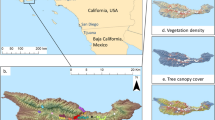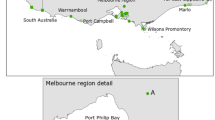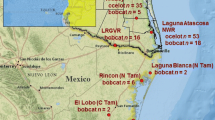Abstract
The Island Night Lizard (Xantusia riversiana) is endemic to three of the Channel Islands off the coast of California, USA. Introduced species such as goats, sheep, and cats have profoundly affected the fauna and flora of the islands for over 150 years, but most of these non-native species have been recently removed. We measured the distribution of genetic diversity in Island Night Lizards across San Nicolas Island using DNA microsatellites to assess the impacts of historical habitat change on effective population size, gene flow, and population divergence; to provide baseline data for future monitoring of genetic diversity; and to provide recommendations to inform the restoration of degraded habitat. Despite a history of profound anthropogenic habitat disturbance, genetic diversity was high within sites, and there was no evidence of population bottlenecks. Divergence between sites was extraordinarily high, as expected for this sedentary species. Landscape resistance modeling using circuit theory showed that unsuitable habitat is relatively permeable to gene flow compared to suitable habitat, and yet populations separated by very short geographic distances remain genetically distinct. We found no evidence of a need for short-term intervention such as artificial translocations to maintain genetic diversity. Instead, we suggest that management should focus on maintaining, improving, and increasing habitat, especially in creating patches of habitat to link existing sites.






Similar content being viewed by others
References
Beier P, Majka DR, Spencer WD (2008) Forks in the road: Choices in procedures for designing wildland linkages. Conserv Biol 22:836–851
Bezy RL, Gorman GC, Adest GA, Kim YJ (1980) Divergence in the Island Night Lizard Xantusia riversiana (Sauria: Xantusiidae). In: The California Islands: proceedings of a multidisciplinary symposium (ed. Power DM), Santa Barbara Museum of Natural History, Santa Barbara, CA, pp. 565–583
Bristol RM, Tucker R, Dawson DA, Horsburgh G, Prys-Jones RP, Frantz AC, Krupa A, Shah NJ, Burke T, Groombridge JJ (2013) Comparison of historical bottleneck effects and genetic consequences of re-introduction in a critically endangered island passerine. Mol Ecol 22:4644–4662
Carlsbad Fish and Wildlife Office (2014) Endangered and threatened wildlife and plants; removing the Island Night Lizard from the federal list of endangered and threatened wildlife. Fed Regist 79:18190–18210
Castillo JA, Epps CW, Davis AR, Cushman SA (2014) Landscape efects on gene flow for a climate-sensitive montane species, the American pika. Mol Ecol 23:843–856
Coonan TJ, Schwemm CA, Garcelon DK (2010) Decline and recovery of the Island fox: a case study for population recovery. Cambridge University Press, New York
Cornuet JM, Luikart G (1997) Description and power analysis of two tests for detecting recent population bottlenecks from allele frequency data. Genetics 144:2001–2014
Cushman S, Wasserman T, Landguth E, Shirk A (2013) Re-evaluating causal modeling with Mantel tests in landscape genetics. Diversity 5:51–72
Davis AR, Corl A, Surget-Groba Y, Sinervo B (2010) Convergent evolution of kin-based sociality in a lizard. Proc R Soc Lond B 278:1507–1514
Do C, Waples RS, Peel D, MacBeth GM, Tillett BJ, Ovenden JR (2014) NeEstimator v2: re-implementation of software for the estimation of contemporary effective population size (Ne) from genetic data. Mol Ecol Resour 14:209–214
Drost CA, Fellers GM, Murphey T, Kleeman P, Halstead B (2015) Population Estimates for Island Night Lizards on San Nicolas Island, California. Unpublished report to United States Navy, Naval Base Ventura County
Drost CA, Fellers GM, Murphey T, Kleeman P, Halstead B, O’Donnell RP (2018) Distribution, habitat, and population size of Island Night Lizards on San Nicolas Island, California. W N Am Nat (in press)
Dubey S, Shine R (2010) Restricted dispersal and genetic diversity in populations of an endangered montane lizard (Eulamprus leuraensis, Scincidae). Mol Ecol 19:886–897
Evanno G, Regnaut S, Goudet J (2005) Detecting the number of clusters of individuals using the software STRUCTURE: a simulation study. Mol Ecol 14:2611–2620
Fellers GM, Drost CA (1991) Ecology of the Island Night Lizard, Xantusia riversiana, on Santa Barbara Island, California. Herpetol Monogr 5:28–78
Fellers GM, Drost CA (1994) Sampling with artificial cover, pp 146–150. In: Heyer WR, Donnelly MA, McDiarmid RW, Hayek L-AC, Foster MS (eds) Measuring and monitoring biological diversity: standard methods for amphibians. Smithsonian Institution Press. pp. xix+364
Fellers GM, Drost CA, Mautz WJ, Murphey T (1998) Ecology of the Island Night Lizard Xantusia riversiana, on San Nicolas Island, California, p 77
Fellers GM, Drost CA, Murphey T (2009) Status of the Island Night Lizard and Two Non-Native Lizards on Outlying Landing Field San Nicolas Island, California. U.S. Geological Survey Open-File Report 2008-1371, p. 22
Fisher RA (1930) The genetical theory of natural selection. Clarendon Press, Oxford
Floyd CH, Van Vuren DH, May B (2005) Marmots on Great Basin mountaintops: using genetics to test a biogeographic paradigm. Ecology 86:2145–2153
Frankham R (1998) Inbreeding and extinction: Island populations. Conserv Biol 12:665–675
Frankham R (2005a) Genetics and extinction. Biolog Conserv 126:131–140
Frankham R (2005b) Stress and adaptation in conservation genetics. J Evol Biol 18:750–755
Gilpin M, Soulé M (1986) Minimum viable populations: processes of species extinction. In: Soulé M (ed) Conservation biology: the science of scarcity and diversity. Sinauer, Sunderland, pp 19–34
Goudet J (1995) FSTAT (version 1.2): a computer program to calculate F-statistics. J Hered 86:485–486
Greenwalt LA (1976) Proposal to determine 2 birds, 1 lizard, 3 snails, and 1 insect, all indigenous to the California Channel Islands, to be endangered species. Fed Regist 41(106):22073–22075
Greenwalt LA (1977) Determination that seven California channel Island animals and plants are either endangered species or threatened species. Fed Regist 42:40682–40685
Guillot G, Mortier F, Estoup A (2005) GENELAND: a program for landscape genetics. Mol Ecol Notes 5:712–715
HDR (2014) Vegetation Classification and Mapping, Naval Base Ventura County, San Nicolas Island, California. Naval Facilities Engineering Command. http://nrm.dfg.ca.gov/FileHandler.ashx?DocumentID=88543
Junak S (2003) Distribution of native cacti (Opuntia spp.) and boxthorn (Lycium californicum) on San Nicolas Island, California. Final report to Southwest Division. Naval Facilities and Engineering Command, San Diego, CA
Junak S (2008) A flora of San Nicolas Island. Santa Barbara Botanic Garden, Santa Barbara, CA, p 235
Komdeur J, Pels MD (2005) Rescue of the Seychelles warbler on Cousin Island, Seychelles: the role of habitat restoration. Biolog Conserv 124:15–26
Luikart G, Allendorf FW, Cornuet J-M, Sherwin WB (1998) Distortion of allele frequency distributions provides a test for recent population bottlenecks. J Hered 89:238–247
Markert JA, Champlin DM, Gutjahr-Gobell R, Grear JS, Kuhn A, McGreevy TJ Jr, Roth A, Bagley MJ, Nacci DE (2010) Population genetic diversity and fitness in multiple environments. BMC Evol Biol 10:205
Mautz WJ (1993) Ecology and energetics of the Island Night Lizard, Xantusia riversiana, on San Clemente Island, California. In: Hochberg FG (ed) Third California Islands symposium: recent advances in research on the California Islands. Museum of Natural History, Santa Barbara, pp 417–428
Mautz WJ (2001) Management plan for the Island Night Lizard, Xantusia riversiana, on San Clemente Island, California. U.S. Navy, Natural Resources Management Branch, Southwest Division Naval Facilities Engineering Command, San Diego, p 71
McRae BH, Beier P (2007) Circuit theory predicts gene flow in plant and animal populations. Proc Natl Acad Sci USA 50:19885–19890
Müllenbach R, Lagoda PJL, Welter C (1989) An efficient salt-chloroform extraction of DNA from blood and tissues. Trends Genet 5:391
Myers N (1979) The sinking Ark: a new look at the problem of disappearing species. Pergamon Press, New York
O’Donnell RP, Drost CA, Mock KE (2014) Development and characterization of 12 microsatellite markers for the Island Night Lizard (Xantusia riversiana), a threatened species endemic to the Channel Islands, California. Conserv Genet Resour 6:699–700
Palstra FP, Fraser DJ (2012) Effective/census population size ratio estimation: a compendium and appraisal. Ecol Evol 2:2357–2365
Palstra FP, Ruzzante DE (2008) Genetic estimates of contemporary effective population size: what can they tell us about the importance of genetic stochasticity for wild population performance? Mol Ecol 17:3428–3447
Peakall R, Smouse PE (2012) GENALEX 6.5: genetic analysis in Excel. Population genetic software for teaching and research—an update. Bioinformatics 28:2537–2539
Pritchard JK, Stephens M, Donnelly P (2000) Inference of population structure using multilocus genotype data. Genetics 155:945–959
Reed DH, Frankham R (2003) Correlation between fitness and genetic diversity. Conserv Biol 17:230–237
Rice WR (1989) Analyzing tables of statistical tests. Evolution 43:223–225
Rick TC, Sillett TS, Ghalambor CK, Hofman CA, Ralls K, Anderson RS, Boser CL, Braje TJ, Cayan DR, Chesser RT, Collins PW, Erlandson JM, Faulkner KR, Fleischer R, Funk WC, Galipeau R, Huston A, King J, Laughrin L, Maldonado J, McEachern K, Muhs DR, Newsome SD, Reeder-Myers L, Still C, Morrison SA (2014) Ecological change on California’s Channel Islands from the Pleistocene to the Antropocene. Bioscience 64:680–692
Riley L, McGlaughlin ME, Helenurm K (2010) Genetic diversity following demographic recovery in the insular endemic plant Galium catalinense subspecies acrispum. Cons Genet 11:2015–2025
Robinson JD, Moyer GR (2013) Linkage disequilibrium and effective population size when generations overlap. Evol Appl 6:290–302
Rosenberg NA (2004) DISTRUCT: a program for the graphical display of population structure. Mol Ecol Notes 4:137–138
Rousset F (2008) GENEPOP’007: a complete re-implementation of the GENEPOP software for Windows and Linux. Mol Ecol Resour 8:103–106
Savage JM (1957) Studies on the lizard family Xantusiidae. III. A new genus for Xantusia riversiana Cope, 1883. Zoologica 42:83–86
Shirk AJ, Wallin DO, Cushman SA, Rice CG, Warheit KI (2010) Inferring landscape effects of gene flow: a new model selection framework. Mol Ecol 19:3603–3619
Smith FDM, May RM, Pellew R, Johnson TH, Walter KR (1993) How much do we know about the current extinction rate? Trends Ecol Evol 8:375–378
Swanson MT (1993) Historic sheep ranching on San Nicolas Island. Technical Series 41. Statistical Research, Inc., Tucson, AZ, p. 82
Wang Y-H, Yang K-C, Bridgman CL, Lin L-K (2008) Habitat suitability modelling to correlate gene flow with landscape connectivity. Landscape Ecol 23:989–1000
Waples RS, Do C (2010) Linkage disequilibrium estimates of contemporary NE using highly variable genetic markers: a largely untapped resource for applied conservation and evolution. Evol Appl 3:244–262
Acknowledgements
The United States Navy and the U.S. Geological Survey provided funding. Bill Hoyer, Martin Ruane, and Grace Smith of Naval Base Ventura County provided funding, logistical support, and helpful discussions. Pat Kleeman, Brian Halstead, Lisa Gelczis, Jake Ahlers, and Sky Bischoff Mattson (USGS) assisted with fieldwork. Steve Junak shared data on the island’s vegetation. Terry Arundel contributed to GIS analyses. Joan Fellers reviewed the manuscript. This work was conducted under Endangered Species permits issued by the US Fish and Wildlife Service to the US Navy and Gary Fellers.
Author information
Authors and Affiliations
Corresponding author
Electronic supplementary material
Below is the link to the electronic supplementary material.
Rights and permissions
About this article
Cite this article
O’Donnell, R.P., Drost, C.A., Fellers, G.M. et al. Rare long-distance dispersal of the Island Night Lizard, Xantusia riversiana, maintains high diversity in a fragmented environment. Conserv Genet 19, 803–814 (2018). https://doi.org/10.1007/s10592-018-1055-x
Received:
Accepted:
Published:
Issue Date:
DOI: https://doi.org/10.1007/s10592-018-1055-x




